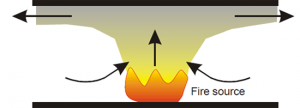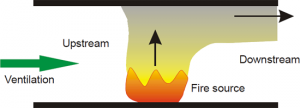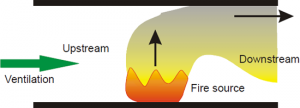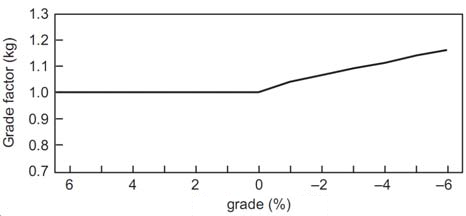Critical Velocity for Smoke Control
The ventilation system would be operated to force the smoke and hot gases in the direction of the empty tunnel to provide a clear and safe environment behind the fire for evacuees and fire fighters. If with no air current (Figure-A) in the fire zone, the smoke progresses in a symmetrical way on both sides of the fire. If the ventilation is weak (Figure-B), the upper layer of heated air and smoke may flow in the opposite direction causing backlayering. If the ventilation capacity is sufficient (Figure-C and Figure-D ), all of the heated air and smoke will flow in the downstream direction.

Figure-A; Smoke progress in case of a fire in a tunnel (natural ventilation)

Figure-B; Vvent < Vc (insufficient mechanical ventilation)

Figure-C; Vvent = Vc (sufficient mechanical ventilation)

Figure-D; Vvent > Vc (sufficient mechanical ventilation)
The occurrence of backlayering depends on many factors including the intensity of fire, the grade and geometry of the tunnel, and the velocity of the ventilating air approaching the fire.
The simultaneous solution of Eqn. (1) and Eqn. (2), by iteration, determines the critical velocity. The critical velocity, Vc, is the minimum steady-state velocity of the ventilation air moving toward a fire that is necessary to prevent backlayering.

Where:
A – Area perpendicular to the flow [(m2)]
Cp – Specific heat of air [(kJ/kg K)]
g – Acceleration caused by gravity [(m/sec2)]
H – Height of duct or tunnel at the fire site [(m)]
K1 – 0.606
Kg – Grade factor
Q – Heat fire is adding directly to air at the fire site [(MW)]
T – Temperature of the approach air [(K)]
Tf – Average temperature of the fire site gases [(K)]
Vc – Critical velocity [(m/sec)]
ρ – Average density of the upstream air [(kg/m3)]

Sources; Numerical Modelling of Movement and Behaviour of Smoke Produced from Fires in the Ville-Marie and L.-H. – La Fontaine Tunnels: Literature Review; Cfd Study Of Fire Protection Systems In Tunnel Fires – Darko Zigar, Desimir Jovanović, Martina Zdravković.
